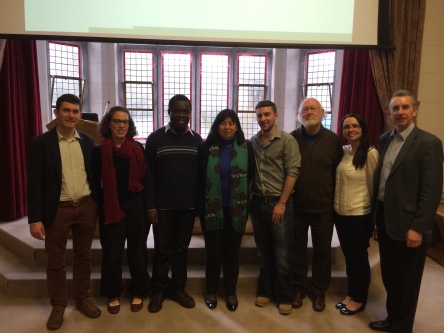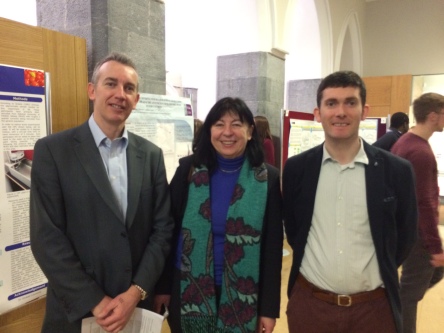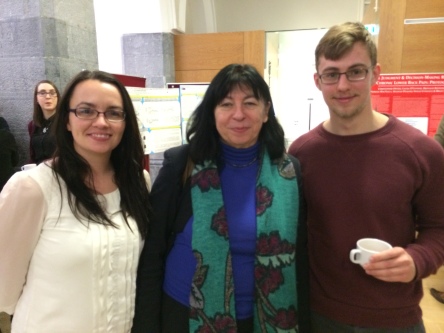By Hannah Durand
 The Centre for Pain Research (CPR) at NUIG recently held its annual Research Day on January 27th 2015. Founded in 2007 by Dr Brian McGuire (Senior Lecturer in Psychology) and Prof. David Finn (Professor in Pharmacology), CPR is an interdisciplinary pain research collaboration between NUIG, the HSE, and related health service agencies. Their aim is to improve our scientific understanding of pain from the basic sciences through to the population level.
The Centre for Pain Research (CPR) at NUIG recently held its annual Research Day on January 27th 2015. Founded in 2007 by Dr Brian McGuire (Senior Lecturer in Psychology) and Prof. David Finn (Professor in Pharmacology), CPR is an interdisciplinary pain research collaboration between NUIG, the HSE, and related health service agencies. Their aim is to improve our scientific understanding of pain from the basic sciences through to the population level.
Since its inception, CPR has had over 100 papers published in scientific journals. These studies have examined very disparate populations in the context of pain; children, older adults, pregnant women, work-disabled chronic lower back pain patients, people with intellectual disabilities, and rats.
Yes, rats.
The centre’s research activity is organised into five research clusters: pre-clinical research; psychological and neuropsychological aspects of pain; pain treatment and pain management; population and policy aspects of pain; and integration of pre-clinical pain research and clinical practice. These clusters were brought together at the CPR one-day showcase of past, present and future research. The full programme can be found here: https://drive.google.com/file/d/0B8_GfmrRjZMNY0x3ZnhITTIwcVk/view?usp=sharing
Prof. Herta Flor, scientific director of the department of Neuropsychology at the University of Heidelberg, gave the first of two keynote lectures entitled ‘Learning and Brain Plasticity in Chronic Pain: Implications for Treatment.’ This talk focused on the role of learning and memory mechanisms in the development and maintenance of chronic pain. Herta also outlined implications for new treatment approaches that focus on the alteration of central pain memories and maladaptive body perception. These included using operant-based extinction training for learned pain associations, as well as imagery, mirror training, and virtual reality to reverse maladaptive changes in pain-related memories such as phantom limb pain.
The second keynote lecture given by Dr Line Caes, lecturer at NUIG and the newest member of CPR Team Pain, was entitled ‘Pain in Childhood: The Importance of Parental Responses and Family Functioning.’ She spoke about how, until the second half of the twentieth century, doctors were taught that infants could not feel pain. It wasn’t acknowledged until the mid 1980s that the provision of adequate anaesthesia and analgesia to infants undergoing surgery was best medical practice on both physiological and humanitarian grounds. It follows that research on paediatric pain is in its relative infancy, although Line is quickly becoming an “international expert” in the area (to quote Brian McGuire). Line discussed her PhD research in Ghent, Belgium, and her postdoctoral research in Halifax, Nova Scotia, in which she examined the role of the parent in child pain. She then outlined her future research ambitions, which include examining the role of entire the family unit in child pain, as well as examining learned pain responses from infancy.
The day also featured short oral presentations by researchers working within the CPR. These presentations covered a wide variety of pain-related topics, including the prevalence, impact, and cost of chronic pain amongst 5-12 year olds in Ireland (Siobhán O’Higgins); how pharmacological manipulation of certain brain regions exerts differential effects on nociception and fear-conditioned analgesia (Kieran Rea); how hyaluronic acid based hydrogels attenuate inflammatory receptor and neurotrophins in an inflammation model of nucleus pulposus cells through binding cell surface receptors (Isma Mohd Isa); and the effectiveness of a cognitive behavioural activation program for people with chronic low back pain (Catherine Quinn).
Finally, poster presentations by staff and students of the CPR covered a broad spectrum of topics within the preclinical and clinical pain research domains. There was a strong show from the psychology group, with posters by Chris Dwyer, Brian Slattery, Laura O’Connor, Angeline Traynor, Bronagh Reynolds, and me. An equally strong show was made by the preclinical group – Nikita Burke, Elaine Jennings, Manish Kumar, Louise Corcoran, Bright Okine, and Marie Fitzgibbon.
The CPR Research Day served not only to demonstrate the important work that is going on in Galway in the field of pain research, but also to highlight the importance of integrating preclinical research, clinical research, and clinical practice. Bridging the gap between these equally important realms of investigation is the next challenge for the CPR, one that will be met with enthusiasm in 2015.
For more information about the CPR and the work currently underway, visit the website. http://www.nuigalway.ie/centre_pain_research/index.html

Hannah Durand completed her BA and HDipPsych in NUIG. She is currently undertaking the MSc in Health Psychology and working part-time as a research assistant in the Centre for Pain Research. Her research relates to the effects of parental catastrophic thinking on child pain experiences in acute pain contexts.


